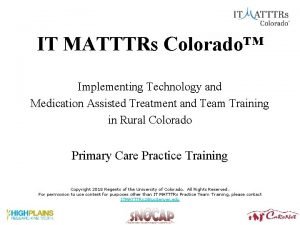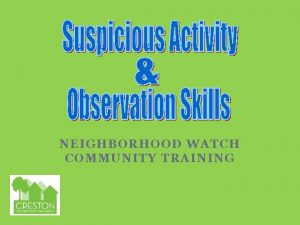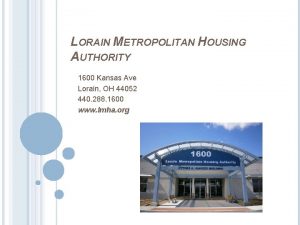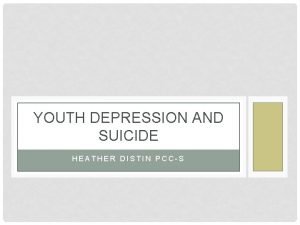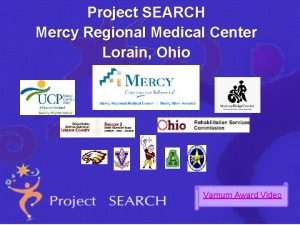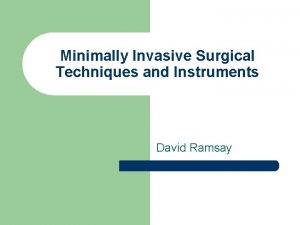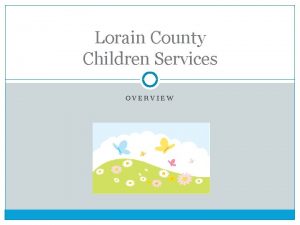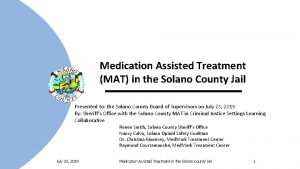MEDICATION ASSISTED TREATMENT MAT PROJECT LORAIN COUNTY SHERIFFS













- Slides: 13

MEDICATION ASSISTED TREATMENT (MAT) PROJECT LORAIN COUNTY SHERIFF’S OFFICE: JAIL OPERATIONS LORAIN COUNTY BOARD OF COMMISSIONERS 1 SEPTEMBER 18, 2019

WHAT IS MAT? Medicated-Assisted Treatment (MAT) is the use of FDA-approved medications, in combination with counseling and behavioral therapies, to provide a "whole-patient" approach to the treatment of substance use disorders. There are three medications commonly used to treat opioid addiction: Methadone – clinic-based opioid agonist that does not block other narcotics while preventing withdrawal while taking it; daily liquid dispensed only in specialty regulated clinics Naltrexone – office-based non-addictive opioid antagonist that blocks the effects of other narcotics; daily pill or monthly injection (Vivitrol) Elaine 2 Buprenorphine – office-based opioid agonist/ antagonist that blocks other narcotics while reducing withdrawal risk; daily dissolving tablet, cheek film, 6 -month implant under the skin, or injectable (Sublocade)

MAT MISCONCEPTIONS A common misconception associated with MAT is that it substitutes one drug for another. Instead, these medications • relieve the withdrawal symptoms and psychological cravings that cause chemical imbalances in the body. • provide a safe and controlled level of medication to overcome the use of an abused opioid. Elaine 3 • show that when provided at the proper dose, medications used in MAT have no adverse effects on a person’s intelligence, mental capability, physical functioning, or employability

MAT OBJECTIVES The ultimate goal of MAT is full recovery, including the ability to live a self-directed life. This treatment approach has been shown to: • Improve patient survival • Increase retention in treatment • Decrease illicit opiate use and other criminal activity among people with substance use disorders • Increase patients’ ability to gain and maintain employment Elaine 4 • Improve birth outcomes among women who have substance use disorders and are pregnant

• Conversation concerning MAT in the jail began in 2015 as a new concept to assist in addressing the opiate epidemic. • In 2016, the Jail began coordinating Vivitrol injections with outside treatment providers for inmates upon release. As of 2018, there approximately 200 jails in 30 states providing MAT using this form of MAT. • Lorain County Sheriff’s Office participated in the Sequential Mapping exercises in 2016 & 2018 with multiple objectives developed to strengthen care coordination from jail to community. Examples: Opiate Screening and Referral pilot, Peer Support, Jail Case Management. • There are several federal cases regarding MAT in the Jail with a growing body of case law to suggest that jails should be continuing MAT if the inmate comes into jail with active prescription. • Diversion of MAT drugs is a real correctional concern. Melissa 5 CONSIDERATIONS RELATED TO JAIL MAT EXPANSION

JAIL OPERATIONS: BEHAVIORAL HEALTH 180 170 160 150 140 130 120 110 100 90 80 70 60 50 40 30 20 10 0 # Daily Average on Psychotropic Meds # of Detox Logs Started # Self Report at Booking: Psychiatric Disorder # Self Report at Booking: Prior MH Hospitalization # Self Report Prior Counseling # Self Report at Booking: Prior Suicide Attempts # Self Report at Booking: Homeless 6 l Ju n Ju ay r M Ap ar M Fe b De c 19 -Ja n t v No Oc Se p g Au Ju ly n Ju ay r M Ap M -F e 18 Melissa ar # Suicide Logs Starts b Number of Inmate Reports Behavioral Health Statistics: 2018 -19 Recap

JAIL OPERATIONS: CURRENT OPIATE DETOX PROTOCOL • Inmates are screened for substance used disorder at booking, during their medical assessment by nurse, and during their mental health assessment by a licensed counselor. • The COWS (Clinical Opiate Withdrawal Scale) Instrument assists medical in determining the stage or severity of opiate withdrawal and assess the level of physical dependence on opioids. • Opiate detox peaks in 72 hours and lasts up to 5 – 7 days. • Inmates experiencing opiate detox are placed on a detox log and given over the counter medications to ease symptoms of detox. • Psycho-social programs conducted in-house by LCADA. • Jail offers NA, AA and other self-help activities. Melissa 7 • Of the 8, 248 inmates detained September 1, 2018– August 31, 2019, 904 came to the jail needing opiate withdrawal management (75 monthly). 32 were pregnant women.

• Vivitrol injections (buprenorphine) are continued for those inmates coming to jail already prescribed this form of MAT. • Subutex (buprenorphine) is prescribed for pregnant females. Subutex prevents the pregnant female from detoxing. Detox can result in preterm labor, fetal distress, or even miscarriage. • Inmates may be referred to Firelands or LCADA Way prior to release with Vivitrol injections coordinated upon release. • Inmates receive a Project Dawn Narcan Training and Kit. To date, 131 inmates have received the Narcan training and kit upon release. • Subutex and Vivitrol is a supported expense of the jail. To date, MHARS has reimbursed the jail $17, 921. 00 Melissa 8 CURRENT OPIATE PROTOCOL

MAT IN THE JAIL: NEW PROTOCOL • Inmates placed on an opiate detox log by jail medical are referred to the MAT Clinic. This is a voluntary program. • Inmates have choice of provider: Firelands or LCADA. • The new MAT Clinic is a dedicated space within the jail specifically established for the MAT clinic. • Hours of operation of the clinic were established consistent with jail schedule. • A special corrections detail has been created to support clinic operations (inmate movement, inmate supervision) This detail is supported by the SOR allocations. Melissa 9 • Education and training is on-going for corrections.

MAT IN THE JAIL: NEW PROGRAM • After clinical review and consultation with the medical doctors, the inmate will receive a VIVITROL® (naltrexone for extended-release injectable suspension) injection or a SUBLOCADE™ (buprenorphine extended-release) injection. • Case Management and Care Coordination are critical elements of the program. • Both providers have clinical staff in place to include licensed prescribers, Physician Assistant or Nurse Practitioners. Dan 10 • On-going program monitoring and outcome assessments completed by all partners: LCSO Jail, MHARS, LCADA, Firelands.

• State Opioid Response Grants (SOR): Formulary Grant from SAMSHA to Ohio. The program aims to address the opioid crisis by increasing access to medication-assisted treatment using the three FDA-approved medications for the treatment of opioid use disorder, reducing unmet treatment need, and reducing opioid overdose related deaths through the provision of prevention, treatment and recovery activities for opioid use disorder (OUD) (including prescription opioids, heroin and illicit fentanyl and fentanyl analogs). • Targeted Community Alternatives to Prison (T-CAP) grant provides funding to Ohio Courts of Common Pleas through Ohio County Boards of Commissioners. The purpose of this grant opportunity is to provide funds to local communities to effectively supervise, provide treatment services and hold accountable low-level, non-violent offenders in the community. • SAMSHA Federal Grant awarded to Firelands Hospital. Elaine 11 FUNDING SOURCES FOR MAT PROJECT

MAT BUDGET: $173, 405 Medical Salaries LCADA: $40, 240. 00 (supported by SOR) Medical Salaries Firelands: $40, 000 (Federal Grant) Clinic Equipment: $6, 165. 00 (supported by TCAP Funds) Medication : $50, 000. 00 (SOR) Corrections Special Detail: $30, 000 (Reimbursed by SOR) Jail Case Manager in support of MAT: $7, 000 (TCAP) Elaine 12 Total: 173, 405

MAT PROJECT SUSTAINABILITY & NEEDS • Partners need to determine how to sustain same level of service and build into or enhance operations. • Partners needs to identify measurable outcomes and use data to make informed decisions. 13 • With additional resources, the Jail has ability to further develop this program so it becomes a normal part of daily medical and behavioral health services.
 Medication assisted treatment colorado
Medication assisted treatment colorado National sheriffs association
National sheriffs association National sheriffs association
National sheriffs association Lorain metropolitan housing authority
Lorain metropolitan housing authority Lorain county coroner reports
Lorain county coroner reports Esc of lorain county
Esc of lorain county Lorain county cps
Lorain county cps Depression lorain
Depression lorain Mercy regional medical center lorain
Mercy regional medical center lorain Lorain journal
Lorain journal Water treatment rockingham county
Water treatment rockingham county What is call computer assisted language learning
What is call computer assisted language learning Hidden costs of assisted living
Hidden costs of assisted living Robot assisted surgery
Robot assisted surgery
